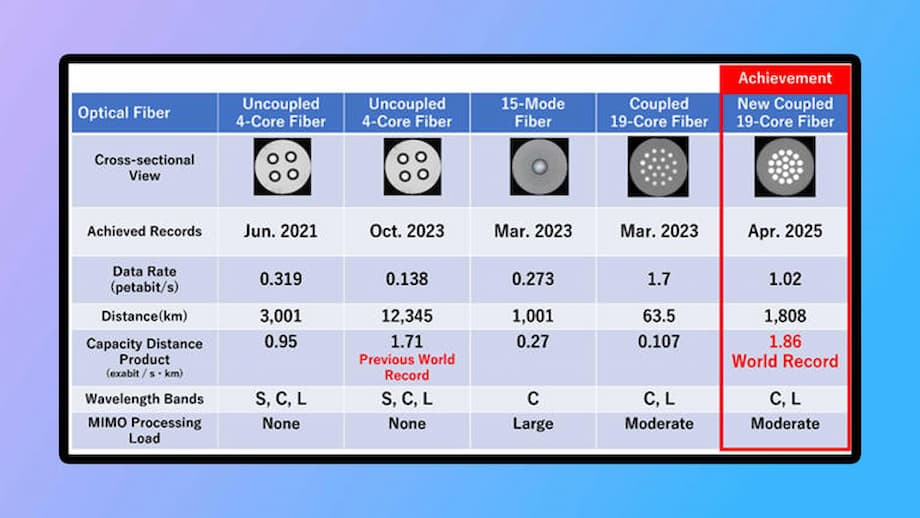Japan’s Breakthrough: The Fastest Internet Speed Ever Recorded
In a stunning leap forward for global communications, researchers in Japan have set a new world record for internet speed, transmitting data at a rate that was previously unimaginable. The achievement, announced by the National Institute of Information and Communications Technology (NICT) at the 48th Optical Fiber Communication Conference in San Francisco, saw over 125,000 gigabytes (GB) of data sent every second across a distance of 1,120 miles (1,802 kilometers). This is about 4 million times faster than the average internet speed in the United States and more than double the previous world record set just a year earlier.
To put this in perspective, at these speeds, you could download the entire Internet Archive in less than four minutes or stream millions of ultra-high-definition movies simultaneously. The implications for the future of the internet, cloud computing, artificial intelligence, and global communications are profound.
How Did Japan Achieve This Record-Breaking Speed?
The secret behind this technological marvel lies in a newly developed optical fiber cable that is thinner than a mechanical pencil but packs the power of 19 standard fiber-optic lines into a single strand. Traditional fiber-optic cables use a single core to transmit data as pulses of light. The Japanese team engineered a cable with 19 individual cores, each capable of carrying its own stream of data. This design multiplies the cable’s capacity without increasing its physical size, making it compatible with existing infrastructure worldwide.
Each of the 19 cores in the cable interacts with light in exactly the same way, which is crucial for minimizing data loss and signal distortion over long distances. In previous experiments, similar speeds were achieved but only over much shorter distances. The new breakthrough comes from maintaining these speeds across more than 1,100 miles, a feat made possible by a sophisticated system of amplifiers and signal loops that preserve data strength and clarity.
Technical Innovations: The 19-Core Optical Fiber
The 19-core fiber is a marvel of engineering. Measuring just 0.127 millimeters in diameter—the same as most existing single-fiber cables—it can be deployed using current network infrastructure. Each core acts like a lane on a superhighway, allowing massive amounts of data to travel in parallel. The researchers also developed advanced amplification systems that boost the signal in all 19 cores simultaneously, using special amplifiers and recirculating loops to simulate the long transmission distance.
At the receiving end, a 19-channel receiver and digital processor clean up the signals and calculate the total data rate. The result: a world record for standard-sized fiber communication, with a capacity-distance product of 1.86 exabits per second-kilometer, the highest ever achieved.
Why Does This Matter? The Global Data Crunch
While most people will never need to download the entire Internet Archive in minutes, the real significance of this breakthrough lies in its potential to address the world’s rapidly growing demand for data. Global internet traffic is exploding due to the rise of streaming services, cloud computing, artificial intelligence, smart cities, and billions of connected devices. According to industry estimates, data volumes are increasing by about 50 percent every year—a trend that shows no sign of slowing down.
Current networks are already straining to keep up. Without new solutions, we could soon face digital bottlenecks that limit innovation and connectivity. The Japanese team’s achievement demonstrates that ultra-high-speed, long-distance fiber networks can be built without changing the size of existing cables, making real-world deployment much easier and more cost-effective.
Comparisons: How Fast Is Fast?
To truly grasp the scale of this accomplishment, consider these comparisons:
- The average fixed broadband speed in the US is about 289 megabits per second (Mbps), or roughly 36 megabytes per second. Japan’s new record is over 125,000 gigabytes per second—about 4 million times faster.
- India’s average internet speed is even lower, making the Japanese achievement 16 million times faster by some estimates.
- At this speed, you could download the entire Netflix library in under a second or the English Wikipedia 10,000 times in a single second.
As one expert put it, “It’s like replacing a single-lane road with a 19-lane superhighway, all within the same space.”
The Science Behind the Speed: Overcoming Technical Barriers
Transmitting data at such high speeds over long distances is not just a matter of adding more fiber cores. Light signals weaken as they travel, and amplifying them across many cores without interference is a major challenge. The NICT team overcame this by ensuring all 19 cores had identical optical properties, allowing light to travel synchronously and minimizing data loss.
The experiment involved sending the data signal through a transmission system 21 times, simulating the full 1,120-mile journey. Advanced amplification and error correction technologies were used to preserve the integrity of the data. The researchers also utilized multi-band wavelength division multiplexing (WDM), which allows multiple data channels to be sent simultaneously over different wavelengths of light, further increasing capacity.
Historical Context: How Far We’ve Come
Internet speeds have improved dramatically over the past three decades. In the early 2000s, home broadband speeds were measured in kilobits or low megabits per second. The previous world record for fiber-optic transmission was 50,250 GB/s, set in 2024. Before that, records were measured in hundreds of terabits per second. The new Japanese record of 1.02 petabits per second (1,020,000 gigabits per second) is a quantum leap forward.
Other notable achievements include:
- 402 terabits per second over 63 kilometers by Aston University in the UK
- 402 terabits per second over 50 kilometers using advanced amplification and spectrum-shaping technologies by NICT in 2024
But none have combined such high speeds with such long distances in a standard-sized cable.
What Does This Mean for the Future?
The implications of this breakthrough extend far beyond faster movie downloads. As the world moves toward the post-5G era, with technologies like self-driving cars, real-time virtual reality, and global AI systems, the demand for reliable, high-capacity networks will only increase. The ability to transmit massive amounts of data over long distances without building entirely new infrastructure could be a game-changer for global connectivity.
According to the NICT team, this technology could become the backbone for:
- Autonomous vehicle networks that require real-time data sharing across cities and countries
- AI systems that learn and operate globally, processing data from millions of sources in real time
- Cloud computing platforms that serve billions of users simultaneously
- Smart cities and the Internet of Things (IoT), where everything from traffic lights to refrigerators is connected
While the technology is still experimental and not yet available for commercial use, the fact that it can be deployed using existing cable infrastructure makes widespread adoption more feasible in the future.
Expert Perspectives and Public Reaction
Experts in the field have hailed the achievement as a major step forward. Dr. Ren Resch, a technology analyst, noted,
“At this new record-breaking speed, you could download the entire Netflix library in under a second. It’s not just about speed—it’s about future-proofing our global communications infrastructure.”
On social media, the news sparked both awe and humor. Some users joked about how such speeds would be used mainly for watching HD videos, while others marveled at the technical prowess required to achieve such a feat. The consensus is clear: Japan’s innovation has set a new benchmark for what is possible in internet technology.
Challenges and Next Steps
Despite the excitement, several challenges remain before this technology can be rolled out on a global scale. The record has not yet been independently verified, and further testing will be needed to ensure reliability and cost-effectiveness in real-world conditions. Additionally, while the cables can fit into existing infrastructure, upgrading the rest of the network (such as routers and switches) to handle such speeds will require significant investment.
The NICT team is now focused on exploring practical applications in telecommunications and working with industry partners to develop commercial solutions. As global data transmission volumes continue to grow exponentially, innovations like this will be essential to avoid digital gridlock.
The Race for Faster Internet: Global Implications
Japan’s achievement puts it at the forefront of the global race for faster, more reliable internet. As countries compete to build the infrastructure needed for the digital age, breakthroughs like this could determine who leads in fields like AI, autonomous vehicles, and next-generation communications.
For now, the rest of the world is left buffering as Japan surges ahead, setting a new standard for what is possible in the realm of high-speed data transmission.
In Summary
- Japanese researchers set a new world record for internet speed: over 125,000 GB per second across 1,120 miles
- The breakthrough was achieved using a 19-core optical fiber cable, no thicker than standard cables, compatible with existing infrastructure
- This speed is about 4 million times faster than average US broadband and would allow downloading the entire Internet Archive in under four minutes
- Technical innovations include advanced amplification, error correction, and multi-band wavelength division multiplexing
- The achievement addresses the growing global demand for data and could become the backbone for future technologies like AI, autonomous vehicles, and smart cities
- While still experimental, the technology demonstrates that ultra-high-speed, long-distance networks are possible without overhauling current infrastructure
- Experts hail the breakthrough as a major step toward future-proofing global communications












